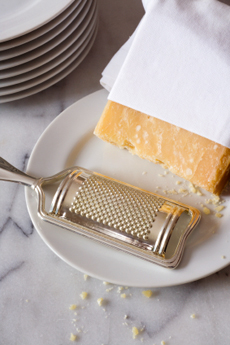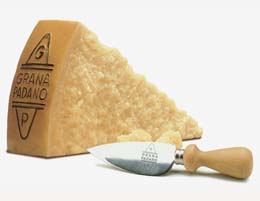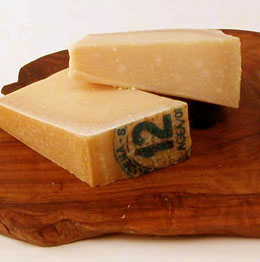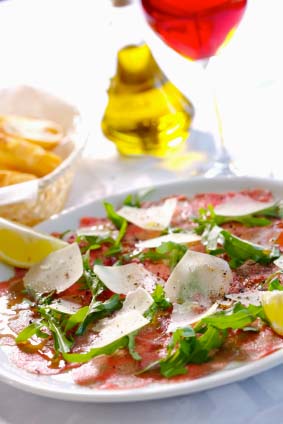

Get ready to grate! You can send your favorite cook a selection of fine grating cheeses from iGourmet. Photo by Y. Yang | IST.
|
STEPHANIE ZONIS focuses on good foods and the people who produce them. KAREN HOCHMAN is Editorial Director of THE NIBBLE.
|
|
September 2007
Updated November 2008
|
 |
Grating Cheese: It’s Great To Grate
Page 5: Grana Padano Cheese
This is Page 5 of an eight-page article on grated cheese. Click on the black links below to visit other pages.
Grana Padano Cheese
Grana Padano is Parmigiano’s cousin: It is almost the same recipe, but is produced outside of Reggio Emilia. The cheese was created around 1,000 C.E. by the Cistercian monks of the Abbey of Chiaravalle, near Milan, and predates its cousin, which began to be produced in the 1400s in Benedictine  monasteries of Bologna, Modena, Parma and Reggio Emilia. Between 1150 and 1200, a large number of cheese makers began to produce Grana Padano; by 1477, according to the website ItalianMade.com, when Parmigiano was a mere newborn not known beyond Reggio Emilia, Grana “was held to be the most famous cheese of Italy.” Today it certainly is the best-selling Italian cheese. monasteries of Bologna, Modena, Parma and Reggio Emilia. Between 1150 and 1200, a large number of cheese makers began to produce Grana Padano; by 1477, according to the website ItalianMade.com, when Parmigiano was a mere newborn not known beyond Reggio Emilia, Grana “was held to be the most famous cheese of Italy.” Today it certainly is the best-selling Italian cheese.
The knife shown in the photo is a special Parmigiano knife, or cotello per Parmigiano. It is used to chip away smaller pieces of Parmigiano-style cheeses, including Grana Padano, or to cut smaller wedges.
While Grana, like Parmigiano, can only be made within a certain region of Italy, that region is enormous, spanning 32 provinces in northern Italy, from Lombardy on the northwest coast, all the way across the country to the Veneto on the northeast coast. This is also known as the Po River Valley—the Po River flows cross-country from west to east. “Padano” means “of the Po River” (from the river’s Latin name, Padus) and “grana” means grainy, the characteristic of the cheese. Unlike today’s fancy marketing names, customers of yore asked for things by origin: Give me the grainy cheese from the Po River, give me the cheese from Parma and Reggio (i.e., Parmigiano-Reggiano) or the cheese from Asiago.
Parma and Reggio, the only town where authentic Parmigiano-Reggiano can be made, are also Po Valley towns, so it’s “all in the family.” Because Grana is made in a much larger area, there is twice as much cheese for sale: four million wheels of Grana are made per year versus two million wheels of Parmigiano, according to Lou DiPalo of DiPalo’s Fine Foods in New York City, a specialist in Italian cheeses. This is why Grana is so much more affordable (and the best-selling cheese).
Like Parmigiano-Reggiano, Grana Padano has its own consortium of producers, the Consorzio Tutela Grana Padano, founded in 1954 to guarantee Grana’s quality, place of origin and method of production. Experts visit each dairy, check each wheel of cheese for proper aroma, texture and taste, and stamp each wheel of cheese with the Consorzio’s mark (you can see it in the photo above).
Both Grana and Parmigiano begin with raw cow’s milk and end up as 80-pound wheels with a straw-colored paste (the interior of a cheese), suitable for grating or eating. The  only difference is that with Grana, the cows are milked in the evening and the milk stands until morning, which allows the cream to rise; it is then partially skimmed off and the cheese is made. The cheese is made a second time in the afternoon using morning milk. Parmigiano is made only once a day using the cold evening milk blended with the warm morning milk (also a combination of whole milk and partially skimmed milk). As with Parmigiano-Reggiano, there is a minimum 12 months of aging, and fine aged Granas can be found here that are 22 months or more. A stravecchio is a Grana that has been aged 15 to 20 months. only difference is that with Grana, the cows are milked in the evening and the milk stands until morning, which allows the cream to rise; it is then partially skimmed off and the cheese is made. The cheese is made a second time in the afternoon using morning milk. Parmigiano is made only once a day using the cold evening milk blended with the warm morning milk (also a combination of whole milk and partially skimmed milk). As with Parmigiano-Reggiano, there is a minimum 12 months of aging, and fine aged Granas can be found here that are 22 months or more. A stravecchio is a Grana that has been aged 15 to 20 months.
Grana Padano available from igourmet.com.
It’s not easy competing when your cousin has already beaten thousands of cheeses in the world to the title, “King of Cheeses.” But the finest Grana Padano is considered by some to be as flavorful as a top Parmigiano—although most would concur that in a blind tasting of the greatest Grana and the greatest Parm, Parm would have the edge. Parm fans say Grana is “less complex”; Grana fans counter that the complexity of Parm tires the palate, while Grana can be snacked upon all day. Like Parm, it is served at every course from appetizers (try it with carpaccio or crudités) to desserts (with berries or melon). The rivalry and debate have been ongoing for centuries, and since taste is subjective, it will never stop.
A good Grana can certainly be complex, offering both sweet and savory flavors. According to GranaPadano.com, though, Grana is more than the best-selling cheese in Italy—it’s “the best selling cheese in the world.” Next time you’re at the cheese counter, try a piece of Grana side-by-side with Parmigiano. However, note that all cheeses are not created equal: Even if you like one better than the other, your cheese monger may be carrying a better quality of one. So, keep trying, every time you have the chance.
Pairing Grana Padano With Food
In addition to grating Grana, Parmigiano and Asiago, you can shave the cheeses for a totally different visual effect and mouthfeel.
- Shave or grate it over the same foods you’d pair with Parmigiano-Reggiano (see the list above).
- Also as with Parmigiano, add it to the cheese board or serve it with as dessert.
Wine Pairing
You can use the wine pairings from Parmigiano-Romano above. But because Grana can be less sharp than Parmigiano, it can also take a less robust red.
Specialty Grana Padano
A kosher-certified D.O.P. Grana Padano is also available—you can find one at iGourmet.com. |

Carpaccio di manzo, or beef carpaccio: thin slices
of raw beef topped with arugula and shaved slices
of Grana Padano, drizzled with olive oil. Photo by
S. Hyman |IST. |
Continue To Page 6: Asiago Cheese
Go To The Article Index Above
Lifestyle Direct, Inc. All rights reserved. Images are the copyright of their respective owners.

|





 monasteries of Bologna, Modena, Parma and Reggio Emilia. Between 1150 and 1200, a large number of cheese makers began to produce Grana Padano; by 1477, according to the website ItalianMade.com, when Parmigiano was a mere newborn not known beyond Reggio Emilia, Grana “was held to be the most famous cheese of Italy.” Today it certainly is the best-selling Italian cheese.
monasteries of Bologna, Modena, Parma and Reggio Emilia. Between 1150 and 1200, a large number of cheese makers began to produce Grana Padano; by 1477, according to the website ItalianMade.com, when Parmigiano was a mere newborn not known beyond Reggio Emilia, Grana “was held to be the most famous cheese of Italy.” Today it certainly is the best-selling Italian cheese.
